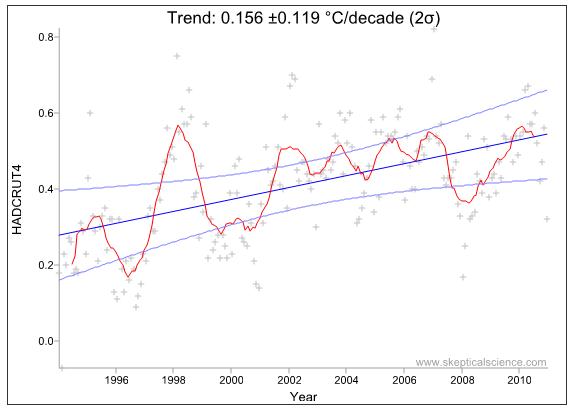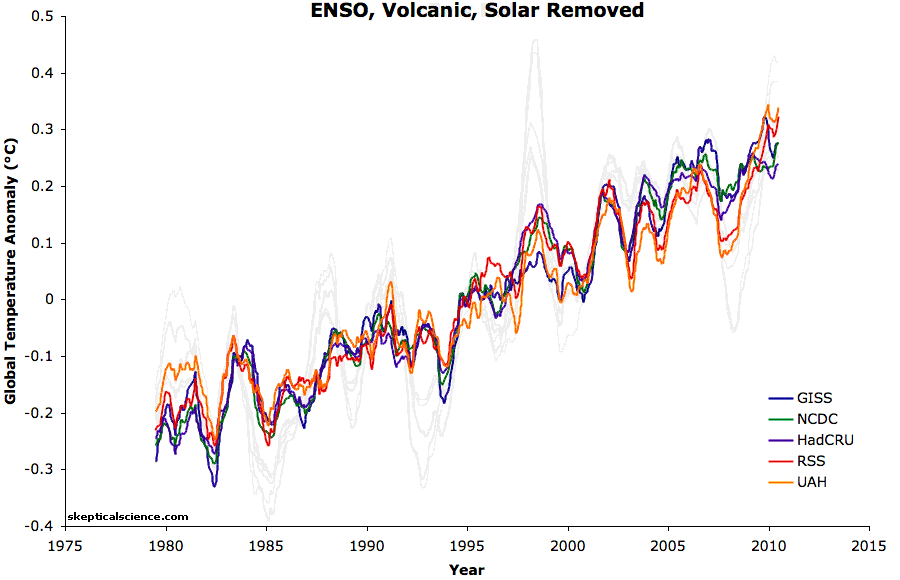Global Surface Warming Since 1995
Posted on 20 April 2012 by dana1981
Santer et al. (2011) examined modeled vs. observed trends in the temperature of the lower troposphere (TLT) and found that climate "skeptics" generally exaggerate the discrepancy between the two. Nevertheless, based on University of Alabama at Huntsville (UAH) and Remote Sensing Systems (RSS) data, TLT is not warming as quickly as models expect. That being said, we don't know if the discrepancy is due to models overestimating TLT, UAH and RSS underestimating it (which is a very plausible possibility), or both.
One key finding from Santer et al. is that we must examine at least 17 years of TLT data to discern a human influence on tropospheric temperatures:
"Because of the pronounced effect of interannual noise on decadal trends, a multi-model ensemble of anthropogenically-forced simulations displays many 10-year periods with little warming. A single decade of observational TLT data is therefore inadequate for identifying a slowly evolving anthropogenic warming signal. Our results show that temperature records of at least 17 years in length are required for identifying human effects on global-mean tropospheric temperature."
Now that another year has passed, we can include 2011 data in this analysis. What we find according to UAH, the TLT trend since February 1995 is 0.12 +/- 0.21°C per decade (using the Skeptical Science Temperature Trend Calculator), and according to RSS, it's 0.048 +/- 0.21°C per decade. Both trends are positive though neither is statistically significant at the 95% confidence level.
Misrepresenting Santer et al.
Nevertheless, despite the preponderance of natural effects acting in the cooling direction over much of this period, both data sets do show a warming trend, albeit not statistically significant at a 95% confidence level. However, climate "skeptics" have misrepresented the work of Santer et al. to argue otherwise:
"Ben Santer recently published research claiming that a 17-year span is the correct period to measure for CO2's influence on global temperatures...Since January 1995, the HadCRUT global temperature anomaly (the IPCC's gold standard) has declined from January 1995's +0.36° to January 2012's +0.22°. Simply put, there has been no statistically significant warming since 1995. And the linear trend over the past 17 years is a minor +0.6°C impact by 2100AD, if that trend were to continue."
[...]
"Conclusion: Human CO2 emissions have had little impact on global temperatures over the near past, which is why there has been no statistically significant warming since 1995."
This quote misrepresents the work of Santer et al. and has many different problems.
First, the 17-year timeframe applied to TLT, not surface temperatures. A similar analysis could be applied to the surface temperature data sets, but to cite Santer et al. (2011) and then proceed to discuss surface temperatures is a misapplication of their work, and shows that the "skeptics" have not read or understood their research.
Second, it seems highly ironic that in the wake of the climate "skeptic" attacks on Phil Jones and the University of East Anglia during the "Climategate" email thefts, it now seems as though every single climate "skeptic" reference to temperature data uses HadCRUT3. More importantly, as we seem to be forced to repeat on a weekly basis recently, HadCRUT3 has a known cool bias and has now been superseded by HadCRUT4. The "skeptics" are relying on a dataset which has been known for more than 2 years to have a cool bias - this is not true skeptical behavior. Figure 1 shows HadCRUT4 over the latest available 17 years (1994 through 2010) courtesy of the SkS Trend Calculator.
Figure 1: HadCRUT4 linear trend and two-sigma uncertainty for 1994 through 2010
Third, Santer et al. simply said that "temperature records of at least 17 years in length are required for identifying human effects on global-mean tropospheric temperature." There is no requirement of statistical significance in this comment. Nevertheless, the trend is statistically significant in HadCRUT4 (Figure 1).
Fourth, even if there were no surface or TLT warming over the past 17 years, that would not be sufficient to conclude that human CO2 emissions have had little impact on temperatures. Without human CO2 emissions, temperatures would have declined over the period in question. Solar activity has been down, there has been a preponderance of La Niñas, human aerosol emissions have risen, etc. The fact that surface temperatures and TLT haven't cooled indicates that there is a warming effect offsetting all of these short-term cooling effects.
Other Surface Temperature Data Sets
It's also worth noting that according to NASA GISS, the surface temperature trend since February 1995 is statistically significant (0.13 +/- 0.12°C per decade). Also note that the GISS and UAH best estimate trends are virtually identical. However, according to NOAA NCDC, the trend since 1995 is not statistically significant (0.095 +/- 0.12°C per decade).
What Does 'Not Statistically Significant' Mean?
Climate "skeptics" often conflate "not statistically significant warming" with "no warming," but this is simply wrong. The term essentially means "we can't rule out the possibility that it isn't warming." However, if you want to argue that there is no warming, then you need a statistical test that rules out the possibility that it is warming, which is a different test altogether. In most cases with these temperature data sets, the possibility that it isn't warming is a small one.
A More Robust Analysis
Perhaps the best way to avoid conflating short-term noise with the long-term human-caused global warming signal is to filter out that noise, as Foster and Rahmstorf (2011) did. Using a statistical multiple linear regression approach to remove the effects of the El Niño Southern Oscillation (ENSO) and solar and volcanic acitivity, Foster and Ramstorf revealed the steady underlying primarily human-caused global warming trend (Figure 2).
Figure 2: Temperature data (with a 12-month running average) before and after the Foster and Rahmstorf exogeneous factor removal
The trends in the various temperature data sets are also in much stronger agreement after the Foster & Rahmstorf filtering is applied (best estimates for 1995 through 2010 between 0.14 and 0.20°C per decade).
As tamino recently showed, over the past decade these three factors have had a cooling effect of approximately 0.13°C of surface temperatures and 0.21°C of TLT. Nevertheless, temperatures have continued to rise, albeit more slowly due to these natural cooling effects.
To make a long story short - global warming continues.































 Arguments
Arguments

























 0
0  0
0 GISTemp global temperatures, with trends for El Niño, neutral, and La Niña years computed separately. Pinatubo years are excluded
Yup, still warming
(latest CRU data included, for the nay-sayers)
GISTemp global temperatures, with trends for El Niño, neutral, and La Niña years computed separately. Pinatubo years are excluded
Yup, still warming
(latest CRU data included, for the nay-sayers)







Comments